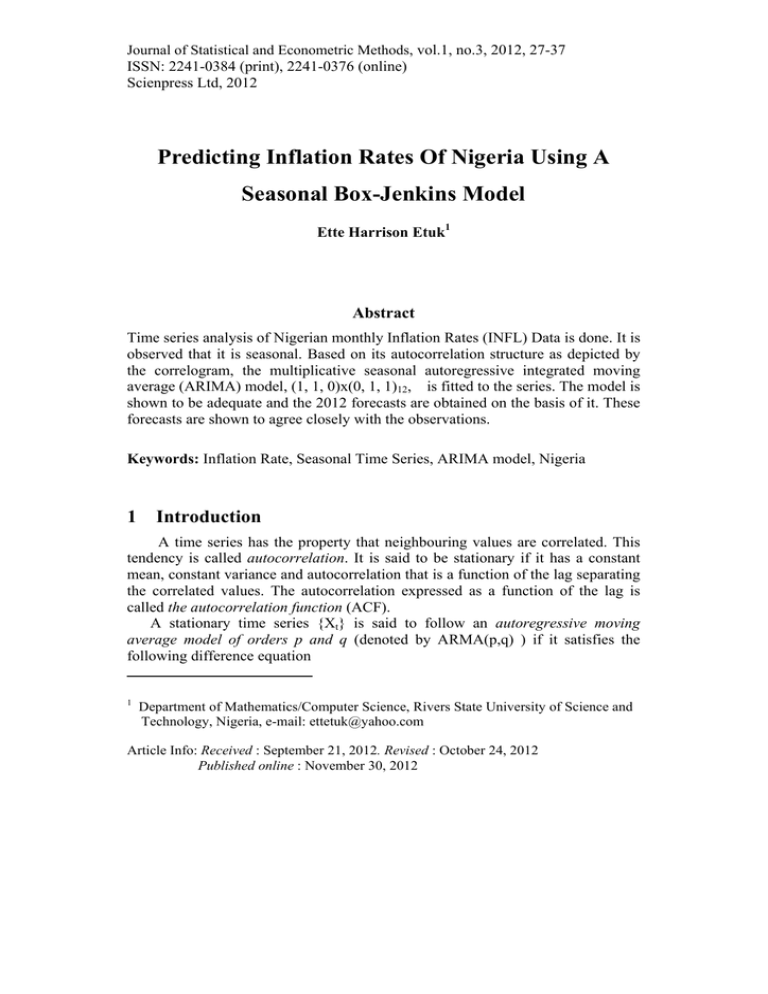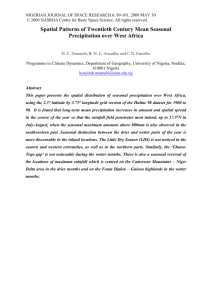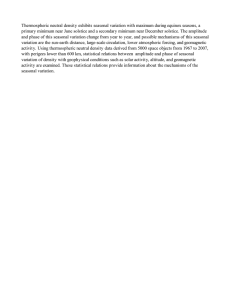Predicting Inflation Rates Of Nigeria Using A Seasonal Box-Jenkins Model Abstract
advertisement

Journal of Statistical and Econometric Methods, vol.1, no.3, 2012, 27-37
ISSN: 2241-0384 (print), 2241-0376 (online)
Scienpress Ltd, 2012
Predicting Inflation Rates Of Nigeria Using A
Seasonal Box-Jenkins Model
Ette Harrison Etuk1
Abstract
Time series analysis of Nigerian monthly Inflation Rates (INFL) Data is done. It is
observed that it is seasonal. Based on its autocorrelation structure as depicted by
the correlogram, the multiplicative seasonal autoregressive integrated moving
average (ARIMA) model, (1, 1, 0)x(0, 1, 1)12, is fitted to the series. The model is
shown to be adequate and the 2012 forecasts are obtained on the basis of it. These
forecasts are shown to agree closely with the observations.
Keywords: Inflation Rate, Seasonal Time Series, ARIMA model, Nigeria
1
Introduction
A time series has the property that neighbouring values are correlated. This
tendency is called autocorrelation. It is said to be stationary if it has a constant
mean, constant variance and autocorrelation that is a function of the lag separating
the correlated values. The autocorrelation expressed as a function of the lag is
called the autocorrelation function (ACF).
A stationary time series {Xt} is said to follow an autoregressive moving
average model of orders p and q (denoted by ARMA(p,q) ) if it satisfies the
following difference equation
1
Department of Mathematics/Computer Science, Rivers State University of Science and
Technology, Nigeria, e-mail: ettetuk@yahoo.com
Article Info: Received : September 21, 2012. Revised : October 24, 2012
Published online : November 30, 2012
28
Predicting Inflation Rates of Nigeria … Box-Jenkins Model
X t 1 X t 1 2 X t 2 ... p X t p t 1 t 1 2 t 2 ... q t q
(1)
or
(L)Xt = (L)t
(2)
where {t} is a sequence of uncorrelated random variables with zero mean and
constant variance, called a white noise process, and the i’s and j’s constants;
(L) = 1 + 1L + 2L2 + ... + pLp
and
(L) = 1 + 1L + 2L2 + ... + qLq
and L is the backward shift operator defined by LkXt = Xt-k.
If p=0, model (1) becomes a moving average model of order q (denoted by
MA(q)). If, however, q=0 it becomes an autoregressive process of order p
(denoted by AR(p)). An AR(p) model of order p may be defined as a model for
which a current value of the time series Xt depends on the immediate past p values:
Xt-1, Xt-2, ..., Xt-p . On the other hand an MA(q) model of order q is whereby the
current value Xt is a linear combination of the immediate past q values of the
white noise process: t- 1, t- 2, ..., t- q. Besides stationarity, invertibility is another
important requirement for a time series. It refers to the characteristic whereby the
covariance structure of the series is unique (Priestley, 1981). In addition it makes
meaningful association of current events with the past history of the series
possible (Box and Jenkins, 1976).
An AR(p) model can be put more specifically:
Xt + p1Xt-1 + p2Xt-2 + ... + ppXt-p = t
Then the sequence of the last coefficients{ii} is called the partial autocorrelation
function(PACF) of {Xt}. The ACF of an MA(q) model cuts off after lag q
whereas that of an AR(p) model is a mixture of sinusoidals tailing off slowly. On
the other hand the PACF of an MA(q) model tails off slowly whereas that of an
AR(p) model tails off after lag p.
AR and MA models are known to have some duality characteristics. These
include:
1. A finite order of the one type is equivalent to an infinite order of the other
type.
2. The ACF of the one type exhibits the same behaviour as the PACF of the
other type.
3. An AR model is always invertible but is stationary if (L) = 0 has zeros
outside the unit circle.
4. An MA model is always stationary but is invertible if (L) = 0 has zeros
outside the unit circle.
Parametric parsimony consideration in model building entails preference for the
Ette Harrison Etuk
29
mixed ARMA fit to either the pure AR or the pure MA fit. Stationarity and
invertibility conditions for model (1) or (2) are that the equations (L) = 0 and
(L) = 0 should have roots outside the unit circle respectively.
Often, in practice, a time series is non-stationary. Box and Jenkins (1976)
proposed that differencing of an appropriate order could render a non-stationary
series {Xt} stationary. Suppose the degree of differencing necessary for
stationarity is equal to d. Such a series {Xt} may be modelled as
p
( (1 ai B i ) dXt = (L)t
(3)
i 1
p
where = 1 – L and in which case (L) = (1 ai B i ) d 0 shall have unit
i 1
roots d times. Then differencing to degree d renders the series stationary. The
model (3) is said to be an autoregressive integrated moving average model of
orders p, d and q and denoted by ARIMA(p, d, q).
1.1 Seasonal ARIMA Models
A time series is said to be seasonal of order d if it has a tendency to exhibit
periodic behaviour after every time interval d. Traditional time series analysis
involves the identification, disintegration and estimation of the traditional
components: secular trend, seasonal component, cyclical component and the
irregular movement. For the purpose of making forecasts, they are reintegrated.
Such techniques could be quite misleading.
The time series {Xt} is said to follow a multiplicative (p, d, q)x(P, D, Q)s
seasonal ARIMA model if
( L ) ( Ls ) d sD X t ( L )( Ls ) t
(4)
where and are polynomials of order P and Q respectively. That is,
( Ls ) 1 1Ls ... P LsP ,
( Ls ) 1 1Ls ... Q LsQ ,
(5)
(6)
where the i and j are constants such that the zeros of the equations (5) and
(6) are all outside the unit circle for stationarity and invertibility respectively. (Ls)
represents the seasonal autoregressive operator whereas (Ls) represents the
seasonal moving average operator.
A seasonal nature is often apparent from the time plot. Moreover for a
seasonal series the ACF or correlogram exhibits a spike at the seasonal lag. Box
and Jenkins (1976) and Madsen (2008) are a few authors that have written
extensively on such models. A knowledge of the theoretical properties of the
models provides basis for their identification and estimation. The purpose of this
30
Predicting Inflation Rates of Nigeria … Box-Jenkins Model
paper is to fit a seasonal ARIMA model to Nigerian Inflation Rate (INFL) series.
Earlier work on Nigerian Inflation rates includes those by Abidemi and Maliq
(2010), Olatunji et al (2010) and Chiakwelu (2012). Whereas Abidemi and Maliq
(2010) think that the inflation rates are stationary, Olatunji et al (2010) think
otherwise. The graph of the inflation rates from 1990 to 2010 given by Chiakwelu
(2012) corroborates the opinion of Olatunji et al. There is perhaps no known
attempt to model Nigerian inflation rates by a seasonal ARIMA model.
2
Materials and Methods
The data for this work are inflation rates – All items (Year on Change)- from
2003 to2011 obtainable from the Data and Statistics publication of Central Bank
of Nigeria retrievable from the website http://www.cenbank.org/.
2.1 Determination of the orders d, D, p, P, q and Q
Seasonal differencing is necessary to remove the seasonal trend. If there is
secular trend non-seasonal differencing will be necessary. To avoid unnecessary
model complexity it has been advised that orders of differencing d and D should
add up to at most 2 (i.e. d + D < 3). If the ACF of the differenced series has a
positive spike at the seasonal lag then a seasonal AR component is suggestive; if it
has a negative spike then a seasonal MA term is suggestive.
As already mentioned above, an AR(p) model has a PACF that truncates at
2
, where
lag p and an MA(q)) has an ACF that truncates at lag q. In practice
n
n is the sample size are the non-significance limits for both functions.
2.2 Model Estimation
The involvement of the white noise terms in an ARIMA model necessitates a
nonlinear iterative process in the model estimation. An optimization criterion
like the least squares, maximum likelihood or maximum entropy is used. An initial
estimate is usually used and each iteration is expected to be an improvement of the
previous one until the estimate converges to an optimal one. However, for pure
AR and pure MA models linear optimization techniques exist (See for example
Box and Jenkins (1976), Oyetunji (1985)). There are attempts to propose linear
methods to estimate ARMA models (See for example, Etuk (1987,1998)). We
shall use Eviews software which employs the least squares approach to analyze
the data.
Ette Harrison Etuk
31
2.3 Diagnostic Checking
The model that is fitted to the data should be tested for goodness-of-fit. To do
this we shall do some residual analysis. In particular we shall plot the histogram of
the residuals and their correlogram. If the model is correct, the residuals would be
uncorrelated and would follow a normal distribution with mean zero and constant
variance. Assuming an adequate model, the autocorrelations of the residuals
should therefore not be significantly different from zero.
3
Results and Discussion
The time plot of the original series INFL in Figure1 shows no clear secular
trend nor seasonality. Seasonal (i.e. 12-month) differencing of the series produces
a series SDINFL also with no trend nor clear seasonality (see Figure 2).
Non-seasonal differencing yields a series DSDINFL with no trend and no clear
seasonality (see Figure 3). Its ACF in Figure 4 has spikes at lags 1 and 12
revealing a seasonality of lag 12. The spike at lag 12 is negative indicating the
involvement of a seasonal MA component of order one. The PACF has a spike at
lag 1 indicating a nonseasonal AR component of order one.
Figure 1: INFL
32
Predicting Inflation Rates of Nigeria … Box-Jenkins Model
Figure 2: SDINFL
Figure 3: DSDINFL
Ette Harrison Etuk
33
Figure 4: Correlogram of DSDINFL
We hereby propose the following (1, 1, 0)x(0, 1, 1)12 model
DSDINFLt = 1DSDINFLt-1 + 12t-12 + t
(7)
The estimation of the model is summarized in Table 1. The model is given by
DSDINFLt = 0.2023DSDINFLt-1 – 0.8858t-12 + t
(0.0672)
(0.0255)
(8)
34
Predicting Inflation Rates of Nigeria … Box-Jenkins Model
The estimation involved 20 iterations. Both coefficients are significantly
different from zero, each being more than twice its standard error. As much as
65% of the variation in DSDINFL is accounted for by the model. The histogram
of the residuals in Figure 5 shows that the residuals are normally distributed with
zero mean indicating model adequacy; the mean of -0.16 is not significantly
different from zero given a standard deviation of 2.1 by t-test. Moreover the
correlogram of the residuals in Figure 6 depicts the adequacy of the model.
Virtually all the residual autocorrelations are not significantly different from zero.
Table 1: Model Estimation
Figure 5: Histogram of residuals
Ette Harrison Etuk
35
Figure 6: Correlogram of the residuals
4 Forecasting
For the model (7) at time t+k we have
Xt+k = 1Xt+k-1 + 12t+-12 + t+k
Obtaining conditional expectations given the series up to time t, we have
Xˆ t (1) 1 X t 12 t 11
36
Predicting Inflation Rates of Nigeria … Box-Jenkins Model
Xˆ t (k ) 1 Xˆ t (k 1) 12 t k 12 , k 2
where Xˆ t (k ) is the k-step ahead forecast from time t.
The 2012 forecasts are given in Table 2. With the actual observed values for
the first seven months of the year being 12.6, 11.9, 12.1, 12.9, 12.7, 12.9 and 12.8
respectively, the chi-square goodness-of-fit test statistic is equal to 4.1132 which
with a p-value of greater than 0.5 is not statistically significant. This further shows
that the model is adequate.
TIME
December 2010
January 2011
February 2011
March 2011
April 2011
May 2011
June 2011
July 2011
August 2011
September 2011
October 2011
November 2011
December 2011
January 2012
February 2012
March 2012
April 2012
May 2012
June 2012
July 2012
August 2012
September 2012
October
2012
November 2012
December 2012
RESIDU
ALS
-1.26140
0.3899
-1.34231
1.70871
-1.39008
1.30454
-2.39750
0.10659
-0.29539
1.21624
-0.81674
0.46909
-0.43875
DSDINFL
SDINFL
INFL
-2.5
-0.2
-2.2
2.5
-1.7
3.2
-3.4
0.3
-0.8
1.1
0.4
0.6
0.8
-2.1
-2.3
-4.5
-2.0
-3.7
-0.5
-3.9
-3.6
-4.4
-3.3
-2.9
-2.3
-1.5
11.8
12.1
11.1
12.8
11.3
12.4
10.2
9.4
9.3
10.3
10.5
10.5
10.3
-0.40
1.11
-1.29
0.97
-0.96
1.93
0.30
0.32
-1.01
0.52
-0.31
0.33
-1.90
-0.79
-2.08
-1.11
-2.07
-0.14
0.16
0.48
-0.53
-0.01
-0.32
0.01
10.2
10.3
10.7
10.2
10.3
10.1
9.6
9.8
9.8
10.5
10.2
10.3
5 Conclusion
The INFL series has been shown to follow a (1, 1, 0)x(0, 1, 1)12 model. This
model has been shown to be adequate. On the basis of the model 2012 forecasts
have been obtained. These forecasts have been shown to agree very closely with
the observed values of the year.
Ette Harrison Etuk
37
References
[1] M.B. Priestley, Spectral Analysis and Time Series, Academic Press, London,
1981.
[2] G.E.P. Box and G.M. Jenkins, Time Series Analysis, Forecasting and
Control, Holden-Day, San Francisco, 1976.
[3] H. Madsen, Time Series Analysis, Chapman and Hall/CRC, London, 2008.
[4] O.I. Abidemi and A.A.A, Maliq, Analysis of Inflation and its determinants in
Nigeria, Pakistan Journal of Social Sciences, 7(2), (2010), 97-100.
[5] G.B. Olatunji, O.A. Omotesho, O.E. Ayinde and K. Ayinde, Determinants of
inflation in Nigeria: A co-integration approach, Contributed paper presented
at the Joint 3rd African Association of Agriculture Eonomists (AAAE) and
48th Agricultural Economists Association of South Africa (AEASA)
Conference, Cape Town, South Africa, September 19 – 23, 2010.
http://ageconsearch.umn.edu/bitstream/96162/2/103.
[6] E. Chiakwelu, Nigeria: Inflation spikes, Naira recoils and T-bills sell
continues, Africa Political and Economic Strategic Center, AFRIPOL;
http://www.afripol.org, (2012).
[7] O.B. Oyetunji, Inverse Autocorrelations and Moving Average Time Series
Modelling, Journal of Official Statistics, 1, (1985), 315-322.
[8] E.H. Etuk, On the Selection of Autoregressive Moving Average Models, An
unpublished Ph. D. Thesis, Department of Statistics, University of Ibadan,
Nigeria, 1987.
[9] E.H. Etuk, An Autoregressive Integrated Moving Average (ARIMA)
Simulation Model: A Case Study, Discovery and Innovation, 10(1-2), (1998),
23-26.







